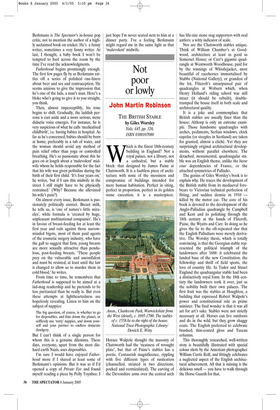Not poor or lowly
John Martin Robinson
THE BRITISH STABLE by Giles Worsley Yale, £45, pp. 320, ISBN 0300107080 Which is the finest 18th-century building in England? Not a royal palace, not a library, not a cathedral, but a stable block: that designed by James Paine at Chatsworth. It is a faultless piece of architecture with none of the messiness and compromise of buildings intended for mere human habitation. Perfect in siting, perfect in proportion, perfect in its golden stone execution, it is a masterpiece.
Horace Walpole thought the masonry of Chatsworth had the ‘neatness of wrought plate’, but that of Paine’s stables has a poetic, Centaurish magnificence, rippling with five different types of rustication (channelled, striated in two directions, pocked and vermiculated). The carving of the Devonshire arms over the central arch has life-size stone stag supporters with real antlers: a witty indicator of scale.
Nor are the Chatsworth stables unique. Think of William Chamber’s at Goodwood, architecture at least as good as Somerset House; or Carr’s gigantic quadrangle at Wentworth Woodhouse, paid for by the winnings of Whistlejacket, most beautiful of racehorses immortalised by Stubbs (National Gallery); or grandest of the lot, Flitcroft’s unsurpassed pair of quadrangles at Woburn which, when Henry Holland’s riding school was still intact (it should be rebuilt), doubletrumped the house itself in both scale and architectural quality.
It is a joke and commonplace that British stables are usually finer than the house; Althorp is only an extreme example. Those handsome quadrangles with arches, pediments, Serlian windows, clock cupolas (or steeples in Scotland) are taken for granted, almost a cliché. Yet they are surprisingly original architectural developments, without parallel elsewhere. The detached, monumental, quadrangular stable was an English theme, unlike the basse cour dependencies of France, or the attached symmetries of Palladio.
The genius of Giles Worsley’s book is to explain why. He traces the development of the British stable from its mediaeval forebears to Victorian technical perfection of fitting, and sudden demise in 1910 killed by the motor car. The core of his book is devoted to the development of the Anglo-Palladian quadrangle by Campbell and Kent and its polishing through the 18th century at the hands of Flitcroft, Paine, the Wyatts and Carr. In doing so he gives the lie to the oft-repeated slur that the English Palladians were merely derivative. The Worsley thesis, which is totally convincing, is that the Georgian stable represented the political triumph of the landowners after 1688: it celebrated the landed base of the new Constitution, the fellowship and thrill of field sports, the love of country life. In Tudor and Stuart England the quadrangular stable had been a distinctively royal form. In the 18th century the landowners took it over, just as the nobility built their own palaces. The first fruit was the stables at Houghton, a building that expressed Robert Walpole’s power and constitutional role as prime minister. The final wonder is that it was all art for art’s sake. Stables were not strictly necessary at all. Horses can live outdoors and do in the wild, but they grow shaggy coats. The English preferred to celebrate brushed, thin-coated gloss and Tuscan columns.
This thoroughly researched, well-written story is beautifully illustrated with special colour shots by the American photographer William Curtis Rolf, and fittingly celebrates a neglected aspect of the English architectural achievement. All that is missing is the delicious smell — you have to walk through the Horse Guards for that.










































 Previous page
Previous page